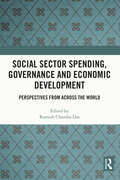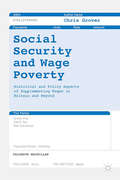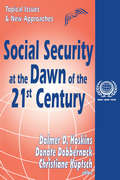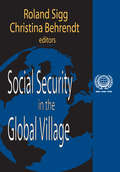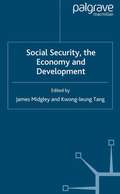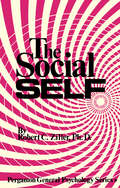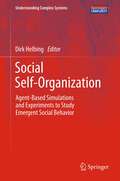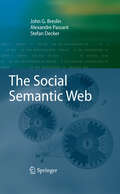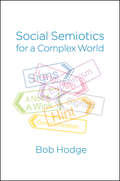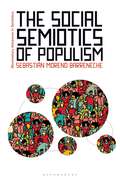- Table View
- List View
Social Sector Spending, Governance and Economic Development: Perspectives from Across the World
by Ramesh Chandra DasEconomic development depends heavily on the growth of social sectors like education, healthcare, gender equality, as well as factors like income, consumption, investment and trade. This book examines the interlinkages between development, good governance and spending on social growth. The book focuses on different areas of social growth, public welfare and poverty reduction including managing human resources, corruption in public institutions and public spaces as well as health and welfare measures. The chapters in the volume highlight the role of government interventions in boosting human development – particularly in developing countries in Asia and Africa and many developed countries in the post-COVID scenario. The book also examines the foundations of government spending on development and effective governance while underlining the impact which social growth has on the economy. Rich in theoretical and empirical perspectives, this book will be useful for students and researchers of economics, sociology, political studies, public finance, development studies as well as for policymakers and think tanks working in the areas of human development.
Social Sector Spending, Governance and Economic Development: Perspectives from Across the World
by Ramesh Chandra DasEconomic development depends heavily on the growth of social sectors like education, healthcare, gender equality, as well as factors like income, consumption, investment and trade. This book examines the interlinkages between development, good governance and spending on social growth. The book focuses on different areas of social growth, public welfare and poverty reduction including managing human resources, corruption in public institutions and public spaces as well as health and welfare measures. The chapters in the volume highlight the role of government interventions in boosting human development – particularly in developing countries in Asia and Africa and many developed countries in the post-COVID scenario. The book also examines the foundations of government spending on development and effective governance while underlining the impact which social growth has on the economy. Rich in theoretical and empirical perspectives, this book will be useful for students and researchers of economics, sociology, political studies, public finance, development studies as well as for policymakers and think tanks working in the areas of human development.
Social Security: False Consciousness and Crisis
by John AttarianOne of today's most important national concerns is the projected bankruptcy of Social Security some time in the next few decades and its consequent inability to pay full benefits on time. Yet despite two decades of warnings about this, nothing is being done. The saying that Social Security is the third rail of American politics - touch it and you die - still holds true. In Social Security: False Consciousness and Crisis, John Attarian argues that the major cause of the current impasse is the misleading manner in which the program has been depicted to the public and the beliefs about Social Security which prevail as a result.
Social Security: False Consciousness and Crisis
by John AttarianOne of today's most important national concerns is the projected bankruptcy of Social Security some time in the next few decades and its consequent inability to pay full benefits on time. Yet despite two decades of warnings about this, nothing is being done. The saying that Social Security is the third rail of American politics - touch it and you die - still holds true. In Social Security: False Consciousness and Crisis, John Attarian argues that the major cause of the current impasse is the misleading manner in which the program has been depicted to the public and the beliefs about Social Security which prevail as a result.
Social Security and Economic Globalization
by Paul J.J. WelfensEconomic globalization is a complex phenomenon where the links between social security expenditures and globalization are not well understood so far. This study summarizes new key findings and highlights new theoretical insights in the field of social security systems, labor standards, taxation and economic globalization. Moreover, new thoughts on the links between social security systems and migration as well as between free trade areas and social market economy development are presented. The book analyzes the role of a changing age dependency using a Branson model and it derives implications for the stock market price index, the exchange rate and the interest rate. Economic globalization needs to be politically managed and through the Transatlantic Banking Crisis and the Euro Crisis the need to more carefully draw the rules of the game for financial globalization has been highlighted. Unstable financial markets have a large potential to undermine social market economies and social security systems. The rising income inequalities within countries raise more policy challenges for Europe than for the US.
Social security and medical care: Proceedings of the post graduate course organised by the foundation for higher medical education Netherlands Antilles
by Dr. G. VeldkampSocial Security and Wage Poverty: Historical and Policy Aspects of Supplementing Wages in Britian and Beyond
by Chris GroverThis is the first book to examine debates about, and the practice of, state supplementing of wages. It charts the historical development of such policies from prohibition in the 1830s and how opposition to it was overcome in the 1970s, thereby allowing the increasing supplementation of the wages of poorly paid working people.
Social Security and Welfare: Concepts And Comparisons (UK Higher Education OUP Humanities & Social Sciences Sociology)
by Robert WalkerWhat are the objectives of social security and social assistance provisions?How can we establish whether these provisions are effective?How do countries differ in the design and effectiveness of their social security systems?This introductory textbook provides a foundation for the systematic study of social security and means-tested social assistance. The book is structured around a model of policy evaluation, which focuses attention on the multiple objectives and outcomes of social security and provides the basis for a multi-disciplinary approach. It progresses from an examination of the varied objectives of social security, via a consideration of key implementation issues, to the establishment of measures of effectiveness and efficiency. Throughout the text theoretical issues are illustrated with reference to the experiences of six countries: the United Kingdom, the USA, Australia, Germany, Sweden and South Korea, to provide an international comparative framework. This is a key textbook for students of social and public policy and economics and essential reading for anyone interested in social security, social welfare and the welfare state.
Social Security at the Dawn of the 21st Century: Topical Issues and New Approaches
by Eugene BardachPresenting a periodic overview of the most significant developments and trends in the field of social security has become, for the International Social Security Association, a tradition and a firm commitment. Benefiting from the vast quantity of information uniquely available to the ISSA, its triennial review takes stock of the current state of social security world wide and focuses, through expert analyses, on some of the most pressing social security issues. Social Security at the Dawn of the 21st Century, the outcome of the most recent review, is intended to significantly extend the access of an international readership to accurate and up-to-date information and analyses on social security, which has without question developed during the twentieth century into one of the most important publicly financed and administered institutions in modern society. The chapters are grouped into two parts. Part one treats subjects related to policy trends and regional developments, with special emphasis on such important issues as redesigning social security programs, new management practices, and the informal care dilemma. It features major aspects of developments in Asia-Pacific and Latin America. Part two focuses on specific program areas, with special emphasis on problems and reforms in employment policy, pension systems, and public disability schemes. Information is also provided on new approaches to ensuring adequate access to health care and on policies in response to changes in family structures as well as an recent experience with social assistance programs.
Social Security at the Dawn of the 21st Century: Topical Issues and New Approaches (International Social Security Ser. #Vol. 2)
by Dalmer D. Hoskins Donate Dobbernack Christiane KuptschPresenting a periodic overview of the most significant developments and trends in the field of social security has become, for the International Social Security Association, a tradition and a firm commitment. Benefiting from the vast quantity of information uniquely available to the ISSA, its triennial review takes stock of the current state of social security world wide and focuses, through expert analyses, on some of the most pressing social security issues. Social Security at the Dawn of the 21st Century, the outcome of the most recent review, is intended to significantly extend the access of an international readership to accurate and up-to-date information and analyses on social security, which has without question developed during the twentieth century into one of the most important publicly financed and administered institutions in modern society. The chapters are grouped into two parts. Part one treats subjects related to policy trends and regional developments, with special emphasis on such important issues as redesigning social security programs, new management practices, and the informal care dilemma. It features major aspects of developments in Asia-Pacific and Latin America. Part two focuses on specific program areas, with special emphasis on problems and reforms in employment policy, pension systems, and public disability schemes. Information is also provided on new approaches to ensuring adequate access to health care and on policies in response to changes in family structures as well as an recent experience with social assistance programs.
Social Security in the Global Village
by Christina BehrendtThere is growing recognition that globalization places major pressures on the development of social security schemes. Internationalization of the economy has important consequences for labor markets: employment is becoming less secure and inequality and social exclusion more pronounced in many countries. At the same time, there are some fundamental socio-demographic changes: new family structures, an aging population, and migration. Increased uncertainty and exclusion intensify the need for social security. Both the public and private sectors are redefining their roles, reshuffling responsibilities between states, markets, families, and individuals. Social Security in the Global Village investigates the new challenges for social security in an increasingly globalized world and analyzes strategies of adjustment. A group of internationally renowned experts in this field assess the variety of effects that globalization has had on national social security schemes. A common theme of a first set of chapters is the relationship between common pressures of globalization and the role of national institutional frameworks in shaping the impact of these pressures on social security. Countries are dealing in different ways with these challenges and follow diverse pathways of adjustment that quite often contradict widespread assumptions about the effects of globalization. A second set of chapters is devoted to challenges in selected policy areas: migration, labor markets, and social cohesion issues. Among the topical issues discussed are the social rights of migrants, the changing rights and obligations in unemployment insurance, lessons to be drawn for the promotion of employment, the relationship between family policy and employment policy for mothers, the management of social risks, and the protection of an adequate income in an active welfare state. Research can help to enlighten and inform the policy debate about the legitimacy of social security in the new, glob
Social Security in the Global Village (International Social Security Ser. #Vol. 8)
by Roland Sigg Christina BehrendtThere is growing recognition that globalization places major pressures on the development of social security schemes. Internationalization of the economy has important consequences for labor markets: employment is becoming less secure and inequality and social exclusion more pronounced in many countries. At the same time, there are some fundamental socio-demographic changes: new family structures, an aging population, and migration. Increased uncertainty and exclusion intensify the need for social security. Both the public and private sectors are redefining their roles, reshuffling responsibilities between states, markets, families, and individuals. Social Security in the Global Village investigates the new challenges for social security in an increasingly globalized world and analyzes strategies of adjustment. A group of internationally renowned experts in this field assess the variety of effects that globalization has had on national social security schemes. A common theme of a first set of chapters is the relationship between common pressures of globalization and the role of national institutional frameworks in shaping the impact of these pressures on social security. Countries are dealing in different ways with these challenges and follow diverse pathways of adjustment that quite often contradict widespread assumptions about the effects of globalization. A second set of chapters is devoted to challenges in selected policy areas: migration, labor markets, and social cohesion issues. Among the topical issues discussed are the social rights of migrants, the changing rights and obligations in unemployment insurance, lessons to be drawn for the promotion of employment, the relationship between family policy and employment policy for mothers, the management of social risks, and the protection of an adequate income in an active welfare state. Research can help to enlighten and inform the policy debate about the legitimacy of social security in the new, glob
Social Security Programs and Retirement around the World: Micro-Estimation (National Bureau of Economic Research Conference Report)
by Jonathan Gruber David A. WiseSocial Security Programs and Retirement around the World represents the second stage of an ongoing research project studying the relationship between social security and labor. In the first volume, Jonathan Gruber and David A. Wise revealed enormous disincentives to continued work at older ages in developed countries. Provisions of many social security programs typically encourage retirement by reducing pay for work, inducing older employees to leave the labor force early and magnifying the financial burden caused by an aging population. At a certain age there is simply no financial benefit to continuing to work. In this volume, the authors turn to a country-by-country analysis of retirement behavior based on micro-data. The result of research compiled by teams in twelve countries, the volume shows an almost uniform correlation between levels of social security incentives and retirement behavior in each country. The estimates also show that the effect is strikingly uniform in countries with very different cultural histories, labor market institutions, and other social characteristics.
Social Security Programs and Retirement around the World: Micro-Estimation (National Bureau of Economic Research Conference Report)
by Jonathan Gruber David A. WiseSocial Security Programs and Retirement around the World represents the second stage of an ongoing research project studying the relationship between social security and labor. In the first volume, Jonathan Gruber and David A. Wise revealed enormous disincentives to continued work at older ages in developed countries. Provisions of many social security programs typically encourage retirement by reducing pay for work, inducing older employees to leave the labor force early and magnifying the financial burden caused by an aging population. At a certain age there is simply no financial benefit to continuing to work. In this volume, the authors turn to a country-by-country analysis of retirement behavior based on micro-data. The result of research compiled by teams in twelve countries, the volume shows an almost uniform correlation between levels of social security incentives and retirement behavior in each country. The estimates also show that the effect is strikingly uniform in countries with very different cultural histories, labor market institutions, and other social characteristics.
Social Security, the Economy and Development
by J. Midgley K. TangThis book explores the complex relationship between social security and economic development, arguing that social security contributes positively to economic development by promoting social investments that not only foster economic growth but enhance social welfare for all. The contributors analyse the various forms of social security, and, through comprehensive analysis of country experiences, demonstrates that the relationship between social security and economic development defies the simplistic interpretations currently popular in literature on the subject. A variety of country case studies are explored including Britain, Chile, China, India, Korea, Norway, Singapore, South Africa and the United States. This topical volume is a vital companion for all interested in the dynamics of the relationship between social security and the economy.
The Social Self: Cognitive, Interpersonal and Intergroup Perspectives (Sydney Symposium of Social Psychology #Vol. 4)
by Joseph P. Forgas Kipling D. WilliamsWhat is the nature of the 'self', how do everyday experiences shape it, and how does it influence our thinking, judgements and behaviors? Such questions constitute enduring puzzles in psychology, and are also of critical practical importance for applied domains such as clinical, counseling, educational and organizational psychology. In this book a select group of eminent international researchers survey the most recent advances in research of the self. In particular, they discuss the influence of cognitive and intra-psychic processes (Part 1), interpersonal and relational variables (Part 2), and inter-group phenomena on the self (Part 3).
The Social Self: Cognitive, Interpersonal and Intergroup Perspectives (Sydney Symposium of Social Psychology)
by Joseph P. Forgas Kipling D. WilliamsWhat is the nature of the 'self', how do everyday experiences shape it, and how does it influence our thinking, judgements and behaviors? Such questions constitute enduring puzzles in psychology, and are also of critical practical importance for applied domains such as clinical, counseling, educational and organizational psychology. In this book a select group of eminent international researchers survey the most recent advances in research of the self. In particular, they discuss the influence of cognitive and intra-psychic processes (Part 1), interpersonal and relational variables (Part 2), and inter-group phenomena on the self (Part 3).
The Social Self: Pergamon General Psychology Series
by Robert C. ZillerThe Social Self is a multifaceted analysis of the self concept based on the social nature of the self. The emphasis is on self-esteem along with self-centrality, self-complexity, social interest, identification, power, marginality, openness, and majority identification. The book relies on an approach based upon non-verbal measures of the self concept and in which the individual is asked to locate himself in relation to a field of significant others, represented in a variety of geometric arrangements using symbols of the self and others.Comprised of nine chapters, this book begins with a description of some of the basic components of the self system including self-esteem, social interest, and marginality. The discussion moves toward more complex analyses including the alienation syndrome and the political personality involving two or more of the components of the social self. The next section focuses on the development of the self concept and examines such variables as socioeconomic background and the history of geographic mobility of the child. A theory of self-other orientation is also considered, along with a helical theory of personal change. This monograph is intended for students of social psychology, personality, sociology, and education who are interested in the self concept, its measurement, and theoretical considerations.
The Social Self and Everyday Life: Understanding the World Through Symbolic Interactionism
by Kathy Charmaz Scott R. Harris Leslie IrvineAn engaging text that enables readers to understand the world through symbolic interactionism This lively and accessible book offers an introduction to sociological social psychology through the lens of symbolic interactionism. It provides students with an accessible understanding of this perspective to illuminate their worlds and deepen their knowledge of other people’s lives, as well as their own. Written by noted experts in the field, the book explores the core concepts of social psychology and examines a collection of captivating empirical studies. The book also highlights everyday life—putting the focus on the issues and concerns that are most relevant to the readers’ social context. The Social Self and Everyday Life bridges classical theories and contemporary ideas, joins abstract concepts with concrete examples, and integrates theory with empirical evidence. It covers a range of topics including the body, emotions, health and illness, the family, technology, and inequality. Best of all, it gets students involved in applying concepts in their daily lives. Demonstrates how to use students’ social worlds, experiences, and concerns to illustrate key interactionist concepts in a way that they can emulate Develops key concepts such as meaning, self, and identity throughout the text to further students’ understanding and ability to use them Introduces students to symbolic interactionism, a major theoretical and research tradition within sociology Helps to involve students in familiar experiences and issues and shows how a symbolic interactionist perspective illuminates them Combines the best features of authoritative summaries, clear definitions of key terms, with enticing empirical excerpts and attention to popular ideas Clear and inviting in its presentation, The Social Self and Everyday Life: Understanding the World Through Symbolic Interactionism is an excellent book for undergraduate students in sociology, social psychology, and social interaction.
The Social Self and Everyday Life: Understanding the World Through Symbolic Interactionism
by Kathy Charmaz Scott R. Harris Leslie IrvineAn engaging text that enables readers to understand the world through symbolic interactionism This lively and accessible book offers an introduction to sociological social psychology through the lens of symbolic interactionism. It provides students with an accessible understanding of this perspective to illuminate their worlds and deepen their knowledge of other people’s lives, as well as their own. Written by noted experts in the field, the book explores the core concepts of social psychology and examines a collection of captivating empirical studies. The book also highlights everyday life—putting the focus on the issues and concerns that are most relevant to the readers’ social context. The Social Self and Everyday Life bridges classical theories and contemporary ideas, joins abstract concepts with concrete examples, and integrates theory with empirical evidence. It covers a range of topics including the body, emotions, health and illness, the family, technology, and inequality. Best of all, it gets students involved in applying concepts in their daily lives. Demonstrates how to use students’ social worlds, experiences, and concerns to illustrate key interactionist concepts in a way that they can emulate Develops key concepts such as meaning, self, and identity throughout the text to further students’ understanding and ability to use them Introduces students to symbolic interactionism, a major theoretical and research tradition within sociology Helps to involve students in familiar experiences and issues and shows how a symbolic interactionist perspective illuminates them Combines the best features of authoritative summaries, clear definitions of key terms, with enticing empirical excerpts and attention to popular ideas Clear and inviting in its presentation, The Social Self and Everyday Life: Understanding the World Through Symbolic Interactionism is an excellent book for undergraduate students in sociology, social psychology, and social interaction.
Social Self-Organization: Agent-Based Simulations and Experiments to Study Emergent Social Behavior (Understanding Complex Systems)
by Dirk HelbingWhat are the principles that keep our society together? This question is even more difficult to answer than the long-standing question, what are the forces that keep our world together. However, the social challenges of humanity in the 21st century ranging from the financial crises to the impacts of globalization, require us to make fast progress in our understanding of how society works, and how our future can be managed in a resilient and sustainable way. This book can present only a few very first steps towards this ambitious goal. However, based on simple models of social interactions, one can already gain some surprising insights into the social, ``macro-level'' outcomes and dynamics that is implied by individual, ``micro-level'' interactions. Depending on the nature of these interactions, they may imply the spontaneous formation of social conventions or the birth of social cooperation, but also their sudden breakdown. This can end in deadly crowd disasters or tragedies of the commons (such as financial crises or environmental destruction). Furthermore, we demonstrate that classical modeling approaches (such as representative agent models) do not provide a sufficient understanding of the self-organization in social systems resulting from individual interactions. The consideration of randomness, spatial or network interdependencies, and nonlinear feedback effects turns out to be crucial to get fundamental insights into how social patterns and dynamics emerge. Given the explanation of sometimes counter-intuitive phenomena resulting from these features and their combination, our evolutionary modeling approach appears to be powerful and insightful. The chapters of this book range from a discussion of the modeling strategy for socio-economic systems over experimental issues up the right way of doing agent-based modeling. We furthermore discuss applications ranging from pedestrian and crowd dynamics over opinion formation, coordination, and cooperation up to conflict, and also address the response to information, issues of systemic risks in society and economics, and new approaches to manage complexity in socio-economic systems. Selected parts of this book had been previously published in peer reviewed journals.
Social Selves: Theories of Self and Society (PDF)
by Ian BurkittThis new, completely revised version builds on the popular success of the first edition. It seeks to answer the basic social question of 'who am I?' by developing an understanding of self-identity as formed in social relations and social activity. Comprehensive, jargon-free and authoritative, it will be required reading on courses in self and society, identity and personality formation.
The Social Semantic Web
by John G Breslin Alexandre Passant Stefan DeckerThe Social Web (including services such as MySpace, Flickr, last.fm, and WordPress) has captured the attention of millions of users as well as billions of dollars in investment and acquisition. Social websites, evolving around the connections between people and their objects of interest, are encountering boundaries in the areas of information integration, dissemination, reuse, portability, searchability, automation and demanding tasks like querying. The Semantic Web is an ideal platform for interlinking and performing operations on diverse person- and object-related data available from the Social Web, and has produced a variety of approaches to overcome the boundaries being experienced in Social Web application areas. After a short overview of both the Social Web and the Semantic Web, Breslin et al. describe some popular social media and social networking applications, list their strengths and limitations, and describe some applications of Semantic Web technology to address their current shortcomings by enhancing them with semantics. Across these social websites, they demonstrate a twofold approach for interconnecting the islands that are social websites with semantic technologies, and for powering semantic applications with rich community-created content. They conclude with observations on how the application of Semantic Web technologies to the Social Web is leading towards the "Social Semantic Web" (sometimes also called "Web 3.0"), forming a network of interlinked and semantically-rich content and knowledge. The book is intended for computer science professionals, researchers, and graduates interested in understanding the technologies and research issues involved in applying Semantic Web technologies to social software. Practitioners and developers interested in applications such as blogs, social networks or wikis will also learn about methods for increasing the levels of automation in these forms of Web communication.
Social Semiotics for a Complex World: Analysing Language and Social Meaning
by Bob HodgeSocial semiotics reveals language's social meaning – its structures, processes, conditions and effects – in all social contexts, across all media and modes of discourse. This important new book uses social semiotics as a one-stop shop to analyse language and social meaning, enhancing linguistics with a sociological imagination. Social Semiotics for a Complex World develops ideas, frameworks and strategies for better understanding key problems and issues involving language and social action in today's hyper-complex world driven by globalization and new media. Its semiotic basis incorporates insights from various schools of linguistics (such as cognitive linguistics, critical discourse analysis and sociolinguistics) as well as from sociology, anthropology, philosophy, psychology and literary studies. It employs a multi-modal perspective to follow meaning across all modes of language and media, and a multi-scalar approach that ranges between databases and one-word slogans, the local and global, with examples from English, Chinese and Spanish. Social semiotics analyses twists and turns of meanings big and small in complex contexts. This book uses semiotic principles to build a powerful, flexible analytic toolkit which will be invaluable for students across the humanities and social sciences.
The Social Semiotics of Populism (Bloomsbury Advances in Semiotics)
by Sebastián Moreno BarrenecheThe concept of 'populism' is currently used by scholars, the media and political actors to refer to multiple and disparate manifestations and phenomena from across both the left and the right ends of the political spectrum. As a result, it defies neat definition, as scholarship on the topic has shown over the last 50 years. In this book, Sebastián Moreno Barreneche approaches populism from a semiotic perspective and argues that it constitutes a specific social discourse grounded on a distinctive narrative structure that is brought to life by political actors that are labelled 'populist'.Conceiving of populism as a mode of semiotic production that is based on a conception of the social space as divided into two groups, 'the People' and 'the Other', this book uses semiotic theory to make sense of this political phenomenon. Exploring how the categories of 'the People' and 'the Other' are discursively constructed by populist political actors through the use of semiotic resources, the ways in which meaning emerges through the oppositions between imagined collective actors is explained.Drawing on examples from Europe, North America and South America, The Social Semiotics of Populism presents a systematic semiotic approach to this multifaceted political concept and bridges semiotic theory and populism studies in an original manner.
